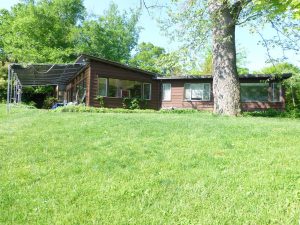
—Historic preservation easement protects in perpetuity Boxwood’s 15.46 acres of woodland and gardens and two Modernist buildings constructed from mid-20th century—
The Boxerwood Education Association has donated to the Virginia Board of Historic Resources a preservation and open-space easement on Boxerwood Nature Center and Woodland Garden, located about one mile west of Lexington in Rockbridge County. The easement, which protects the property from future subdivision and development, will be administered by DHR, which listed the historic core of the property on the Virginia Landmarks Register in 2015, when the National Park Service also placed it on the National Register of Historic Places. Beginning in the mid-20th century, the nearly 15-and-one-half-acre property was the residence of Dr. Robert and Elizabeth Munger, who named it Boxerwood. It features two Modernist buildings, Munger Lodge and Orchard House. The compact, single-story lodge, formerly the Mungers’ home, was built in 1952, making it one of the earliest examples of Modernist architecture in Rockbridge County. The house’s Modernist elements—including a stone chimney core, under-floor radiant heating, a hearth-centered open-space floor plan, and built-in cabinets and bookcases—suggest the influence of architect Frank Lloyd Wright’s “Usonian” residential designs of the mid-20th century. In 1956, Boxerwood’s Roanoke-based architects William Gordon Wells and Richard Leo Meagher added a multipurpose room to the house, now enclosed with glass, with a concrete floor segmented into rectangles by wood strips, a pattern inspired by Japanese tatami mats. They also designed a butterfly-roofed guest house, today’s Orchard House, which is still used for residential purposes. The one-time Munger residence, now housing the offices of the Boxerwood Education Association (BEA), is distinguished as well by intersecting shed-roofed wings, redwood and stone cladding, and a window wall with views of the Mungers’ legacy—an extensive eleven-acre garden and arboretum. Avid gardeners and specimen collectors, the Mungers started developing the garden and arboretum in 1957, ultimately planting more than 12,000 trees and shrubs without a formal plan. Although neither of the Mungers was trained in landscape design, horticulture or arboriculture, they traveled to Japan and China on tours organized by noted horticulturist Dr. H. Marc Cathey, one-time director of the U.S. National Arboretum. While the Mungers acquired some specimens on those trips, the majority of their plants came from a nursery in Maryland. Over time, the Mungers grew more methodical and design oriented in their plantings, with the most prominent section, featuring ornamental conifers, arising on an eastern slope visible from Munger Lodge’s great room and terrace. Today Boxerwood boasts more than 2,500 mature specimen and native trees and shrubs; the Nature Center and Woodland Garden is used by BEA for educating over 2,500 local school children and other visitors about ecosystems, natural resource conservation, watershed management, and environmental stewardship. Under the easement, to be managed by staff of the Department of Historic Resources (DHR), BEA will continue to promote watershed protection—Boxerwood lies within the Maury River drainage system—through careful stewardship of the property’s wetlands. Its woodland garden will continue to sustain a habitat for an array of birds and other wildlife. The BEA will continue to deliver its environmental education programs and keep Boxerwood open to the public. Other character-defining cultural landscape features preserved by the easement include two ponds, gardens for plants and vegetables, fieldstone walls, outdoor classrooms, a greenhouse, an enclosed play area for children, and a system of paths and trails. There is also a family burial crypt containing the remains of Robert and Elizabeth Munger. Additionally, Boxerwood features 15 modern sculptures as well as an early 20th-century frame barn and a stucco concrete spring house built around 1956. “The value of an easement such as this one for Boxerwood is that it protects unique mid-century Modernist architectural resources and a dynamic historic landscape of woodlands, gardens, and paths that along with its natural resources creates a wonderful sanctuary—importantly, one open to the public,” said Julie V. Langan, director of DHR. “This easement helps ensure that Boxerwood can continue to fulfill its mission ‘to educate and inspire people of all ages to be environmentally responsible stewards of the earth,’” adds Catrien van Assendelft, director of BEA. “We are grateful to everyone who has helped make it possible to protect this environmental and cultural treasure for perpetuity.” BEA allows public access to the property seven days a week. The Boxerwood easement, which was made possible in part by a grant from the Virginia Land Conservation Foundation, was recorded August 23 in Rockbridge County Courthouse. The easement augments more than 350 acres of land in Rockbridge County and Lexington already protected by historic preservation and conservation easements held by the Virginia Board of Historic Resources.Programs
DHR has secured permanent legal protection for over 700 historic places - including 15,000 acres of battlefield lands
DHR has erected 2,532 highway markers in every county and city across Virginia
DHR has registered more than 3,317 individual resources and 613 historic districts
DHR has engaged over 450 students in 3 highway marker contests
DHR has stimulated more than $4.2 billion dollars in private investments related to historic tax credit incentives, revitalizing communities of all sizes throughout Virginia